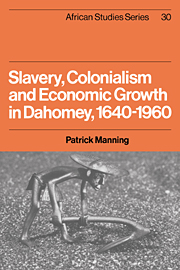Book contents
- Frontmatter
- Contents
- Maps
- Tables
- Figures
- Preface
- 1 Slavery, colonialism and economic growth, 1640–1960
- 2 The Dahomean economy, 1640–1890
- 3 Struggles with the gods: economic life in the 1880s
- 4 Production, 1890–1914
- 5 Demand, 1890–1914
- 6 Exchange, 1890–1914
- 7 The alien state, 1890–1914
- 8 Social struggles for economic ends, 1890–1914
- 9 The mechanism of accumulation
- 10 Capitalism and colonialism, 1915–60
- 11 The Dahomean national movement
- 12 Epilogue
- Notes
- Appendix 1 Export revenue from Dahomey, 1640s–1950s
- Appendix 2 Slave exports by ethnic origin
- Appendix 3 Population loss due to slave exports
- Appendix 4 Foreign trade of Dahomey
- Appendix 5 Foreign trade indices
- Appendix 6 Rainfall
- Appendix 7 Fiscal flows
- Appendix 8 Money supply of colonial Dahomey
- Bibliography
- Index
- Frontmatter
- Contents
- Maps
- Tables
- Figures
- Preface
- 1 Slavery, colonialism and economic growth, 1640–1960
- 2 The Dahomean economy, 1640–1890
- 3 Struggles with the gods: economic life in the 1880s
- 4 Production, 1890–1914
- 5 Demand, 1890–1914
- 6 Exchange, 1890–1914
- 7 The alien state, 1890–1914
- 8 Social struggles for economic ends, 1890–1914
- 9 The mechanism of accumulation
- 10 Capitalism and colonialism, 1915–60
- 11 The Dahomean national movement
- 12 Epilogue
- Notes
- Appendix 1 Export revenue from Dahomey, 1640s–1950s
- Appendix 2 Slave exports by ethnic origin
- Appendix 3 Population loss due to slave exports
- Appendix 4 Foreign trade of Dahomey
- Appendix 5 Foreign trade indices
- Appendix 6 Rainfall
- Appendix 7 Fiscal flows
- Appendix 8 Money supply of colonial Dahomey
- Bibliography
- Index
Summary
The commodity exchange mode of production provides the fundamental continuity in the economic history of Dahomey. Estimates of per capita money holdings give a striking illustration to this continuity: money holdings, although showing some growth, were of the same order of magnitude for the late eighteenth, the late nineteenth and the mid-twentieth centuries.This commodity exchange system of peasant agriculture, fishing, manufactures and marketing–closely articulated with nonmarket familial production and with the West African mercantile structure–developed in relative isolation, evolved and expanded in its interaction with other modes of production once trans-Atlantic commerce began, and remains a sector of major importance to this day.
Economic changes–qualitative transformations in the modes of production and quantitative growth in the economy–unfolded under the influence of four major forces, both internal and external in origin: the domestic mechanism of accumulation, the changing influence of West African and world markets, the development of industrial technology and the capitalist mode of production, and, finally, the state, both precolonial and colonial. The influence of these forces of change, however, was limited by the rate of growth, which has been incremental and evolutionary, rather than rapid or discontinuous. External influences, while they have been a positive stimulus to growth at times, halted and reversed the region's growth in the eighteenth and the twentieth centuries. Slave exports brought a decline in Aja population beginning in the 1690s, but rising prices brought peaks in export revenue in the 1730s and 1780s; exports then declined and the devastated population began to grow again.
- Type
- Chapter
- Information
- Slavery, Colonialism and Economic Growth in Dahomey, 1640–1960 , pp. 281 - 285Publisher: Cambridge University PressPrint publication year: 1982

